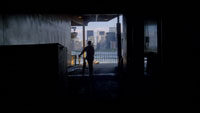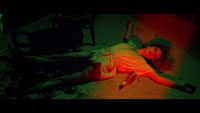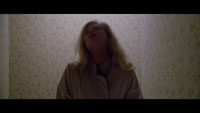**/**** Image A Sound A- Extras B-
starring Jack Hedley, Almanta Keller, Howard Ross, Paolo Malco
screenplay by Gianfranco Clerici, Vincenzo Mannino, Lucio Fulci, Dardano Sacchetti
directed by Lucio Fulci
by Bryant Frazer The box art for this Lucio Fulci sleazefest describes it as "The Most Controversial Horror Film Ever Made," which is a stretch. "Notorious" would be a better word. The New York Ripper's main claim to fame is its reputation as a sadistic, gory, and generally misogynist giallo–the Italian term referring to a combination of the crime and horror genres (basically a whodunit with slasher elements) that became popular in the 1960s and endured through the 1970s. Released in 1982 and styled after the psychologically ambitious thrillers of Hitchcock, it bears roughly the same relationship to the gialli film cycle that, say, Touch of Evil does to film noir. If the Fulci film isn't exactly as self-aware as the Welles one, it still functions as a capper, a fitting culmination of a particular form.
|
In the early 1980s, Fulci's output was veering heavily towards the supernatural with wild, bloody titles like Zombi 2, City of the Living Dead, and The Beyond (which enjoyed a new life as a midnight-movie release after Quentin Tarantino championed it in the late 1990s). But The New York Ripper, featuring authentic location photography in scuzzy New York locales that strongly recalled images from films like Taxi Driver and Cruising, was a departure in that it has no otherworldly elements. Fulci's killer stalks New York women and mutilates them with an unmistakably sexual aggression, although he's apparently not a rapist. He's a stock genre character except for one thing: he talks like Donald Duck, complete with frenzied quacking noises. (I am not making this up.) And there's nothing fantastic about the murders on screen, except in the sense that Fulci stages them so well, with moments that occasionally evoke a real sensation of terror–confusion, isolation–before the inevitable death occurs.
Storywise, Fulci doesn't take any chances. The film begins with an old man walking his dog on the East River near the Brooklyn Bridge, and nobody should be surprised when the friendly mutt, rooting around in the grass, emerges with a woman's severed hand clamped in his jaws. The English actor Jack Hedley is credible enough as Fred Williams, a hard-bitten police lieutenant assigned to the case. (In one scene, he's lectured by his boss, played by none other than Fulci himself.) Any number of red herrings are floated (is the slasher the gay intellectual? The creepy coroner? The Olympian-in-training?) as the cop searches for a pattern to the killings and as the Ripper continues to strike, killing one young woman on a boat in New York Harbor, another in her dressing room at a 42nd Street sex club, yet another in the labyrinthine halls of the kind of hotel where you rent rooms by the hour. The investigation doesn't gain traction, however, until one beautiful would-be victim (Antonella Interlenghi, credited as Almanta Keller) actually survives the cretin's assault. Only when the killer's motives are revealed (they involve a little girl in a hospital bed) is his identity discovered.
The desultory nature of the production, moving from murder scene to murder scene with cynical efficiency, is a shame, given that Fulci clearly shows some stuff as a director. A routine attack in the front seat of an automobile near the beginning of the film is distinguished by Fulci's decision to go the extra mile in staging and shooting it on the Staten Island Ferry, so that the skyline of lower Manhattan itself appears to be in motion outside. In one unpleasant scene, a woman gets it in the crotch, but her subsequent death tableau–her upper torso lit in the colours of Christmas–has a compellingly sickly quality. And a sequence in the middle of the film, in which a nude Alexandra Delli Colli, having engaged in bondage play with a stranger, begins to suspect that her partner is the Ripper and starts working to untie those knots as he slumbers next to her, is a terrific horror set-piece.
As for the allegations of misogyny, well, I'd like to argue that the attitudes here are merely retrograde sexism, though they do verge on the pernicious, whether Fulci ever realized it or not. I don't think Fulci hates women, per se (at least, not any more than he may hate men), but the film has a resolutely paternalistic and condescending tone. Most questionable is its sanctimonious view of promiscuity. This Ripper is a threat not just to sex performers and prostitutes, but also to women who simply sleep around (our scowling detective scolds a husband for allowing his wife the sexual freedom that allegedly made her a target) and one ill-fated bicyclist whose attention-grabbing transgression seems to have been the wearing of a pair of tiny shorts. Journalists Luca M. Palmerini and Gaetano Mistretta got Fulci to say this about the film's sexual content in an interview published in their book Spaghetti Nightmares: "I don't consider [the sex scenes] gratuitous, I think they're fitting, because anyone who tries to kill beautiful women, whether they be loose ladies, professional prostitutes or just young girls, has got a problem which is possibly caused by having a daughter, who is not going to be a winner, in a country like America where being a winner is compulsory." Even if Fulci is trying to suggest that his film has a social dimension, the film's prescriptive, fear-mongering approach to female sexuality is a real problem.
Outside of so moralizing a context, the film's oft-cited gore effects–such as the on-camera slashing of breasts, a nipple, and, of course, an eyeball (was this leitmotif of Fulci's a tip of the razor blade to Buñuel?)–could be more easily defended as Grand Guignol. The fact remains that if you have the constitution for it, this is a surprisingly entertaining film–not a good film, but a diverting one whose unpleasant sexual politics are leavened somewhat by its baldly formulaic nature, including what I have to assume are unintentionally hilarious interludes that find the killer taunting the cop by telephone. At one point, Williams is asleep in bed with a hooker when the Ripper calls to say (and I do quote), "It happened again–it happened again tonight. Quack quack quack!" Horror fans have known this for years: The New York Ripper is more than a crappy slasher movie–it's the quintessential crappy slasher movie.
| Click for hi-res BD captures |
 |
 |
 |
THE BLU-RAY DISC
Aptly, the new Blu-ray Disc from Blue Underground has to be described as the quintessential version of The New York Ripper, delivering a mind-bogglingly good, negative-sourced HD transfer that's apparently free of censorship or any of the other editing shenanigans that have resulted in reported alterations to the film over the years. The image looks like a great 35mm print from the era should, boasting the right amount of film grain and picture detail. The movie was shot in the two-perf Techniscope format, meaning each frame of camera negative has only half the resolution of a CinemaScope (i.e., four-perf) frame, and this 1080p (MPEG-4/AVC) transfer, letterboxed to 2.35:1, seems to capture every last bit of visual information. Fine detail has not been noise-reduced out of existence, hence tiny bits of dust are sometimes visible. The film takes up 18.8 GB on a 25 GB disc, with another 2.41 GB reserved for menus and extras.
Selectable audio formats are the film's original monaural mix, encoded in lossy Dolby Digital 2.0, and a new DTS-HD MA 7.1 soundtrack. The inclusion of the latter feels almost like a joke (it reminded me of the old Criterion LaserDisc of Monty Python and the Holy Grail, which offered a Japanese dub for no good reason), yet the all-ADR dialogue has better definition on the DTS track, and the surrounds are used tastefully, mainly for an expansion of the music soundstage. (Not once did I hear anything else coming from the two speakers behind my couch, thank God, but it's possible there was something back there.) While it's a far cry from those lousy early 5.1 "remixes" of mono soundtracks that simply spread an increasingly thin soundtrack across six channels, the ideal would've been to make a lossless mono option available.
Extras are sparse. "'I'm an Actress!': Zora Kerova" (10 mins.) is a lively talking-head interview (in HD with DTS 2.0 audio) wherein the actress discusses her experience on The New York Ripper (she portrayed the live-sex-show performer who takes a broken bottle to the crotch) and her impressions of Fulci, whom she met for the first time on the set. (He's not a woman-hater, she says, just a humanity-hater.) Although seemingly left untroubled by the experience, she recalls that it was embarrassing at the time and recounts the uncomfortable reception she received from the Communist authorities in her native Czechoslovakia, who were unimpressed with her choice of roles. "I would have done it all over again, especially with Fulci!" she declares. As a bonus, she goes on to discuss her work on the infamous Cannibal Ferox, in which she appeared in an iconic gore scene suspended by hooks through her breasts. "NYC Locations Then and Now" (4 mins.) contrasts contemporary HD video footage of locations from the film with their '82 counterparts. Finally, The New York Ripper's theatrical trailer (3 mins.) is on board the disc in a good-quality letterboxed version that's grain-free and softer and smearier than the feature's own transfer. It's an indicator of what a more careless Blu-ray presentation of the movie might have looked like. As usual, Blue Underground has done a phenomenal job. Originally published: October 27, 2009.


![Conquest (1983); Contraband (1980); Zombie (1979) - DVDs|Zombie (1979) [2-Disc Ultimate Edition] - Blu-ray Disc Conquest (1983); Contraband (1980); Zombie (1979) - DVDs|Zombie (1979) [2-Disc Ultimate Edition] - Blu-ray Disc](https://filmfreakcentral.net/wp-content/plugins/contextual-related-posts/default.png)